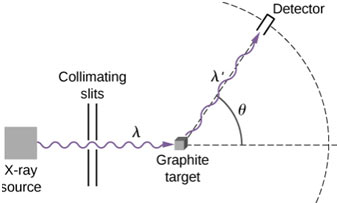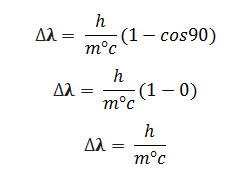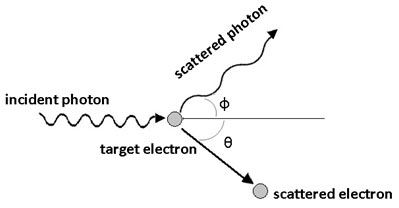Introduction to Arthur Compton
Arthur Holly Compton was a teacher at Washington University, researching the scattering of X-rays when he found the effect that is named after him in 1922. Compton developed a concept of the strength of X-ray reflection from crystals as a means of studying the position and dimensions of electrons and also atoms. In 1918 he started a study of X-ray scattering.
Compton effect
“The phenomenon of change in the wavelength of an X-ray after collision with the electron is called Compton effect.”
Dealing with X-rays, he refined his apparatus to measure the shift of wavelength with scattering angle that is currently referred to as the Compton effect. The Compton effect is defined as the decrease in energy (rise in wavelength) of an X-ray or gamma-ray photon when it communicates with the matter.
This impact demonstrates that light cannot be described simply as a wave phenomenon. Compton’s work offered to persuade proof that in scattering experiments, light behaves as a beam of particles whose energy is symmetrical to the regularity (i.e., vice versa symmetrical to the wavelength).
As a result of the interaction, the electron is given part of the energy and a photon including the continuing to be energy is produced in various directions from the initial so that the total momentum of the system is conserved.
Explanation
- θ = Let the angle made by scattered x-rays with original direction.
- λi=Wavelength of the incident x-ray
- λs =Wavelength of the incident and scattered x-rays.
According to Compton,
λs>λi
Compton Shift
By applying the laws of momentum and energy to the collision, Compton derived an expression for the change in wavelength ∆λ.
Compton shift for scattering angle is θgiven as

Here ∆λ shows the change in wavelength known as Compton Shift for scattering angle θ. mᵒis the rest mass of the electron, c is the velocity of light.
Experiment of Compton
A graphite target was bombarded with monochromatic x-rays as well as the wavelength of the scattered radiation was measured with a revolving crystal spectrometer. The intensity was figured out by a movable ionization chamber that created a current symmetrical to the x-ray intensity. Compton determined the dependency of scattered x-ray strength on the wavelength at three different scattering angles of 45ᵒ, 90ᵒ, as well as 135ᵒ.

Compton Wavelength
The factor ![]() is called Compton wavelength as it has the dimensions of length. Let say the scattering angle is 90ᵒ, then
is called Compton wavelength as it has the dimensions of length. Let say the scattering angle is 90ᵒ, then

The numerical value of this is,

MCQs about Compton Effect
- Who discovered the phenomenon known as the Compton Effect?
- A) Albert Einstein
- B) Marie Curie
- C) Arthur Holly Compton
- D) Max Planck
- Answer: C) Arthur Holly Compton
- What is the Compton Effect?
- A) Increase in energy of X-rays after collision with electrons
- B) Change in direction of X-rays after collision with atoms
- C) Decrease in wavelength of X-rays after collision with electrons
- D) Generation of X-rays from electron bombardment
- Answer: C) Decrease in wavelength of X-rays after collision with electrons
- How did Arthur Compton refine his apparatus to measure the Compton effect?
- A) By increasing the intensity of X-rays
- B) By measuring the shift of wavelength with scattering angle
- C) By changing the composition of the target material
- D) By decreasing the speed of electrons
- Answer: B) By measuring the shift of wavelength with scattering angle
- What does the Compton shift represent?
- A) Change in intensity of X-rays
- B) Change in speed of electrons
- C) Change in wavelength of X-rays
- D) Change in direction of X-rays
- Answer: C) Change in wavelength of X-rays
- According to Compton’s explanation, how does the wavelength of scattered X-rays compare to the wavelength of incident X-rays?
- A) λs < λi
- B) λs = λi
- C) λs > λi
- D) λs ∝ λi
- Answer: C) λs > λi
- What physical quantity does the Compton shift depend on?
- A) Electron charge
- B) Scattering angle
- C) Target material
- D) X-ray intensity
- Answer: B) Scattering angle
- What was used to measure the wavelength of scattered radiation in Compton’s experiment?
- A) Revolving crystal spectrometer
- B) Ionization chamber
- C) Photographic plate
- D) Geiger counter
- Answer: A) Revolving crystal spectrometer
- What does the Compton wavelength represent?
- A) Length of the target material
- B) Length of the X-ray source
- C) Length of the scattered radiation
- D) Length associated with the momentum of photons
- Answer: D) Length associated with the momentum of photons
- In the Compton experiment, what was the dependency of scattered X-ray intensity measured against?
- A) Intensity of incident X-rays
- B) Wavelength of incident X-rays
- C) Scattering angle
- D) Target material composition
- Answer: B) Wavelength of incident X-rays
- What physical quantity does the Compton shift equation involve?
- A) Electron charge
- B) Speed of light
- C) Scattering angle
- D) Planck’s constant
- Answer: C) Scattering angle
- What factor is considered the Compton wavelength?
- A) Scattering angle
- B) Compton shift
- C) Speed of light
- D) Rest mass of the electron
- Answer: D) Rest mass of the electron
- What is the change in wavelength known as for a given scattering angle in Compton effect?
- A) Compton wavelength
- B) Compton shift
- C) Restoring wavelength
- D) Scattering wavelength
- Answer: B) Compton shift
- What experiment did Arthur Compton use to demonstrate the Compton effect?
- A) Crystallography
- B) Spectroscopy
- C) Graphite target bombardment with X-rays
- D) Photoelectric effect
- Answer: C) Graphite target bombardment with X-rays
- What dimensions does the Compton wavelength have?
- A) Time
- B) Charge
- C) Length
- D) Mass
- Answer: C) Length
- What principle did Compton apply to derive an expression for the change in wavelength?
- A) Laws of thermodynamics
- B) Laws of momentum and energy
- C) Quantum theory
- D) Relativity
- Answer: B) Laws of momentum and energy
- What is the Compton Effect?
- Answer: The Compton Effect refers to the phenomenon of the change in the wavelength of X-rays or gamma-ray photons after they collide with electrons.
- Who discovered the Compton Effect?
- Answer: The Compton Effect was discovered by Arthur Holly Compton in 1922 while researching X-ray scattering.
- How did Arthur Compton refine his apparatus to measure the Compton Effect?
- Answer: Arthur Compton refined his apparatus to measure the shift in wavelength with scattering angle, which is now known as the Compton Effect.
- What does the Compton Shift represent?
- Answer: The Compton Shift represents the change in wavelength of X-rays or gamma-ray photons due to the Compton Effect.
- What is the significance of the Compton Effect in understanding the nature of light?
- Answer: The Compton Effect demonstrates that light cannot be described simply as a wave phenomenon, but behaves as a beam of particles with energy proportional to their frequency.
- How is the change in wavelength calculated in the Compton Effect?
- Answer: The change in wavelength (∆λ) is calculated using an expression derived from the laws of momentum and energy applied to the collision between photons and electrons.
- What was the setup of Arthur Compton’s experiment to study the Compton Effect?
- Answer: Compton’s experiment involved bombarding a graphite target with monochromatic X-rays and measuring the wavelength of the scattered radiation using a revolving crystal spectrometer.
- What is the Compton Wavelength?
- Answer: The Compton Wavelength, also known as the Compton Factor, represents the length associated with the momentum of photons involved in the Compton Effect.
- What physical principles are applied in understanding the Compton Effect?
- Answer: The Compton Effect is understood using the laws of momentum and energy conservation, as well as concepts from quantum theory and relativity.
- How does the scattering angle affect the Compton Shift?
- Answer: The Compton Shift is dependent on the scattering angle, with a larger angle resulting in a larger shift in wavelength.
- What are the further applications or implications of the Compton Effect?
- Answer: The Compton Effect has applications in various fields, including physics, chemistry, and medical imaging, and contributes to our understanding of the behavior of electromagnetic radiation.
- Is the Compton Effect observable only with X-rays, or does it apply to other forms of electromagnetic radiation?
- Answer: While the Compton Effect was first observed with X-rays, it applies to other forms of electromagnetic radiation, including gamma rays.
- How did the Compton Effect contribute to the development of quantum theory and modern physics?
- Answer: The Compton Effect provided experimental evidence supporting the wave-particle duality of light and contributed to the development of quantum theory, leading to significant advancements in modern physics.
Wrapping up Understanding the Compton Effect: A Paradigm Shift in Light Behavior
Introduction to Arthur Compton
Arthur Holly Compton, a distinguished physicist and educator at Washington University, embarked on a groundbreaking journey in 1922, unraveling a phenomenon that would forever alter our perception of light. Compton’s research into X-ray scattering led him to the discovery of an effect now known as the Compton Effect.
Exploring the Compton Effect
The Compton Effect, as elucidated by Arthur Compton, delineates the alteration in the wavelength of X-rays following their collision with electrons. Compton meticulously refined his experimental setup to measure the wavelength shift corresponding to varying scattering angles, thereby cementing the foundations of this revolutionary concept.
Unveiling the Compton Shift
At the crux of the Compton Effect lies the Compton Shift, a manifestation of the change in wavelength resulting from the interaction between X-rays and matter. Compton, through rigorous application of the laws of momentum and energy, derived an expression to quantify this shift, unraveling the intricacies of light-matter interactions.
Experimental Insights: The Experiment of Compton
Compton’s experimental prowess came to the fore in his meticulous study of the Compton Effect. By bombarding a graphite target with monochromatic X-rays and meticulously measuring the wavelength of scattered radiation across various scattering angles, Compton provided empirical validation of his theoretical framework.
Delving into the Compton Wavelength
A pivotal concept arising from the Compton Effect is the Compton Wavelength, also known as the Compton Factor. This parameter, bearing the dimensions of length, underscores the profound implications of the Compton Effect on our understanding of the momentum associated with photons.
Implications and Applications
The revelation of the Compton Effect transcends mere scientific inquiry, permeating diverse realms such as physics, chemistry, and medical imaging. Its profound implications have paved the way for advancements in fundamental science and technological innovation, shaping our contemporary understanding of electromagnetic phenomena.
Conclusion: Pioneering Insights into Light Phenomena
In conclusion, Arthur Compton’s seminal work on the Compton Effect stands as a testament to the power of scientific inquiry and experimental ingenuity. By unraveling the particle-like behavior of light, Compton ushered in a new era of exploration, leaving an indelible mark on the annals of scientific discovery.

